by Susan | Feb 24, 2014 | Plantswoman Design
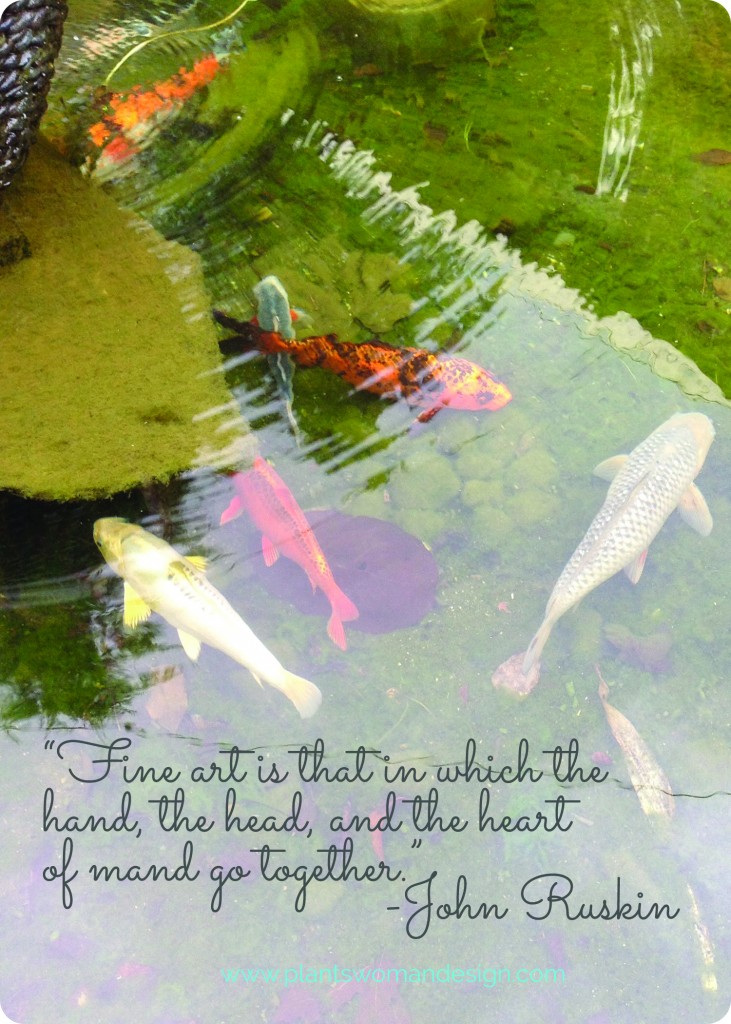
‘Art in Bloom’ was the theme of the NWFGS this year and it was interesting to see all the way’s designers incorporated art, used art as a focal point, and used different mediums of art in the gardens. There is a debate going on now in artistic circles about whether gardens can be art in the first place. Gardens are an ever changing medium that evolves, is augmented by pruning, more plantings and removal of elements. Exploring the garden as an art form was my take on ‘Art in Bloom’. Sometimes artists cross over into garden design and sometimes designers cross over into artists. A beautifully drawn plan can be like a painting. Just like drawing or painting uses different techniques so too does the designer uses different techniques to present a garden as art. Textures, form , scale, and colors all enter into the planning and planting of a garden.
I wanted the whole garden to be seen as an expression of art.
Many people expressed appreciation and even judges said ‘I get it’ which was fun to hear. Doing the garden show is exhausting and exhilarating at the same time. Even we get amped up for spring by seeing the blooming flowers and water features, knowing that outside our flowers aren’t really blooming and the water features while probably running are not what they will be in a few short weeks. My fish are still hibernating and sluggishly laying on the bottom of the pond (pictured above). The lilies are not blooming yet and my other floating pond plants are still in the green house waiting for the water temperature to warm. The hellebores are just starting to raise their heads and I’m starting to see shoots of bulbs emerging from the soil. Walking through the doors of the garden show and feeling the warmth and energy of happy people lightens the heart, and makes winter not seem so tiring.
Even with all that, garden show gardens are hard to create. If you want an inside look at how we created our garden click here. Every year I try to focus on creating something my fellow gardeners can relate to. I want to spark their imagination, show something they haven’t seen before, present ideas to take home. Not every garden has the same impact on every person so trying to appeal to a broad audience and please the judges at the same is a tight rope walk. Maintaining my focus, not getting caught up in competitiveness, is key for me. Obviously budget constraints, forcing issues, labor issues, and time constraints always add to the difficulty of presenting a show garden. The show was the first week of February this year which shortened the forcing time. Trying to express that this garden is a show garden and should be seen as a part of a whole garden was also challenging. Imagining the gardens at the show in a slightly morphed way helps to think about it at your house. Seeing where the door is in your minds eye, or how the grass paths lead to another pathway to another area of the garden help to see the gardens in relationship.
With that in mind, here are some tips for visiting the garden show next year (I’ll try to remember to re-post next year before the show starts again).
1. Go more that one day. It is very difficult to see everything in one day. Some gardens or displays may strike you as boring, but they may just be subtle. Looking at them again will help to see more. They could strike you as too jumbled but then when you go back you might see just that one piece or plant that would be perfect in your garden.
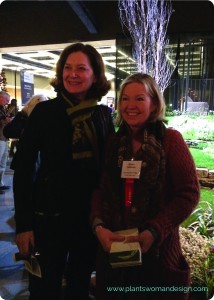
2. Talk to people. Either other attendees, speakers, or the people in the gardens themselves. They are usually eager to share knowledge, expertise or even directions to the bathroom. Gardening is so enjoyable that like minded people like to share.
- sharing with garden writer
Julie Moir Messervey
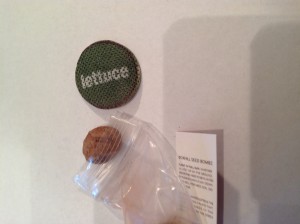
Lettuce bombs
3 Try something new. There are lots of plants, bulbs, shoots, and tubers in the plant market. Some of these plants are a great price and are hard to find in the nursuries. There are seeds and advice as to how to start them. New seed strains, new ways to grow them (seed bombs), and even heirloom varieties are available here Connecting with local nurseries will help to form bonds and connections for plants throughout the year.
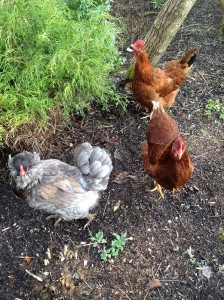
unpaid cultivators
4. Learn something new. Seminars , speakers, and the DIY stage are informative and fun. New ideas are presented. HHT (horticultural hot topics) are discussed. Learning about ways to volunteer, gardens to visit, and problems that are affecting our plant world are important and the garden show is a good place to learn about them. Most speakers are people just like you and me and they are happy to share what they know. You will see the newest books, and maybe sign up to receive newsletters or blog posts via email. I really like to follow blogs that present me with more questions than answers (some people prefer it the other way around). Check out… Gardenista.com, wellywoman. heavypetal.ca, reddirtramblings.
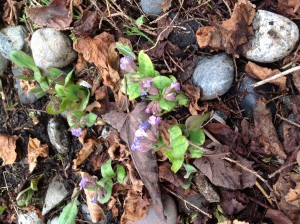
pulmonaria Azurea
5. Share what you know. After the garden show share what you learned with friends and family, how important it is to you and how important gardening is to the planet. The stewardship we share will improve the quality of life around us. It is so important to garden like your life depended on it, because in reality it does. Joining a gardening club, working with a pea patch, sharing your gardening skills and know how with younger people will insure that the awareness and importance of gardening is not lost. The farm to table movement was started in this way. I love the people who came through that were with a group, staying at a hotel, and were there for the whole show. Lots of gardeners from Canada!. Their passion is very real and they enjoyed every moment of the show.
As I think about the time table for the coming year I start to plan what I would like to do and I want to share with you about Little Bites. Little Bites is about teaching and empowering our younger generations about gardening little bites at a time (get it?). You can plant a seed, watch it grow and eat it instead of opening the refrigerator. Instead of watching other people’s lives on our various screens lets get out there and learn how to grow food and flowers, eat invasives, divide corms, do soft wood cuttings, design for sustainablitly… Whoops maybe I should RELAX and get some much needed rest…… Nah, I’ll rest when I loose the ability to get outside by myself. Needless to say we, here at Plantswoman Design, are excited about Little Bites and what we can accomplish when we work together outside. Stay tuned for more information and an invitation to get involved!
by Susan | Feb 3, 2014 | Plantswoman Design
Today was a long day. After leaving the Convention Center after 11pm last night we were back at it at 8am this morning. You may remember we mentioned a very big game yesterday so we had to keep focused and we worked right up to game time when we took a break to watch our Hawks dominate the Broncos. Whew, what a game! We headed out for the evening around 8:30pm and were met by a city ready to party. People flooded the streets and car horns were blaring in celebration. Traffic getting into the city was thick. We made it out with out incident and are ready for some rest before we finish things up tomorrow. Here is a quick peak at what we accomplished today and we look forward to posting many more photos tomorrow.
by Susan | Feb 2, 2014 | Plantswoman Design
Here’s the thing… It’s not like I’m not busy or anything but when an opportunity presents itself you just have to take it and list your house for sale. I know, I know, it could be better timing but there you have it. I’ve listed my house and have my eye on lovely piece of property in the next neighborhood over. So, once the garden show is over I hope to have more news to share with you. In the meantime, I thought the photos of realtor had taken of my home and garden were great and wanted to share with you. So, here is a little tour of the place I call home.
by Susan | Jan 29, 2014 | plants, Plantswoman Design
I have an obsession with plants. Just like a wino on a street corner with a brown paper wrapper around his obsession I wait at the mail box for mine. Dreaming of the fabulous plants, wondering if I could try something new, and finally clicking ‘ORDER”… I am always tempted by mail order catalogs that come in the mail and online and have ordered so many plants over the years just from descriptions in catalogs. Dan Hinkley’s Heronswood Catalog is fun to read just for the entertainment factor. I heard him speak this year about how hard it was to come up with those individualized descriptions.
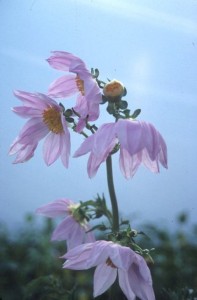
Grows to 108 inches tall Dahlia Imperialis
Now there are several I look at each year. Since I live on the Pacific Coast so many things can grow here. One of my favorite catalogs is the Plant Delights catalog. Even wrapped in brown paper from North Carolina they get here in great shape. I get a quarterly newsletter with an update plus the annual catalog. Tony Advent grows some amazing things there. I love to get the unusual things that are hardy in my area and also things like colocasia’s and gingers that are not. Every plant I have received from him, although small, has thrived. I’ve tried the huge Dahlia imperialis which is a Giant Tree Dahlia. The catalog promised that it would grow large in my area (it did) but would not bloom (it didn’t) because of lack of heat. The foliage was amazing and well worth the cost. He has 6 different liropes with only one available in my area nursery. This is just a small sampling of plant delights at Plant Delights Catalog.
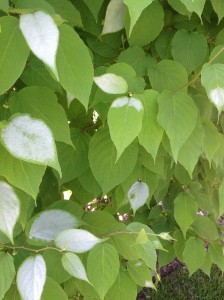
Silver Vine Actinidia Polygama
Forest Farm in Oregon has been selling mail order for many years. They are a small group of dedicated gardeners that grow usual and unusual plants. Many trees and shrubs along with perennials. The first time I got a small ‘tube’ with a tree inside I was petrified. I planted it and put stakes and twine around it so it wouldn’t get trampled. It did grow and was happy, putting on substantial height and branches in just a year. I’m not so afraid of these ‘tree tubes’ now and will often order for my customers things that I can’t find in the nursery’s here. For example, the Silver Vine (Actinidia Polygama) is a great vine that should be more readily available. Forest Farm had it so I ordered it for my client. I sometimes put smaller baby plants into a pot so I can grow them on a little before I place them for a client. They also have a great selection of unusual fruit trees.
Oregon is only about 3 hours from my home. Just across the border is another wonderful nursery Cistus Nursery on Sauvie Island next to the Columbia River. They sell both retail and mail order. I am addicted to browsing that nursery because there are some larger specimens there that can fit in the back of my truck. This is about the time each year I go down and visit. They also have a lot of plants available to send mail order. They specialize in Agaves, hardy tropicals, and drought tolerant plants. Many cactus varieties too. Manzanitas that are hardy and hardy Begonias too. I planted two of my favorite things (see blog post ‘These are a few of my favorite things) from here. The Camellia sinensis ‘blushing Maiden’, and the magnolia laevifoila (Michelia yunnanensis).
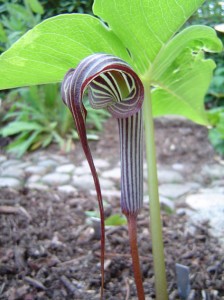
Arisaema franchetianum
A regular contributor to Fine Gardening Magazine Kelly Dodson also grows near by. His nursery Far Reaches Farm is an amazing place to visit. He is also an great gardener with practical knowledge about how to grow what he sells. He grows hardy (and non hardy) tropicals, including orchids. Amazing ferns, Arisaemas, and Mediterranean plants grow in greenhouses while hardy primroses, berberis varieties, and shrubs grow outside on the ground. Many of his offerings are available mail order. He has fans all over our area and beyond of the brown paper variety.
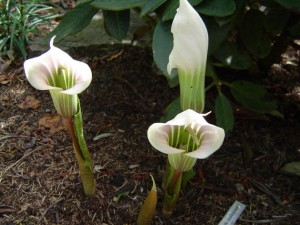
Arisaema candidissimum
Even closer to me is a new venture opening up soon. Dragonfly Farms Nursery has been open in Hansville for several years but this year they are doing something a little different. If you know the owner, Heidi Kaster, you are not surprised by that. She is starting up a mail order business in conjunction with her retail outlet. Heidi has always done a fabulous job growing seeds from all over the world. She will be getting back to that and selling what she grows. She is also teaming up with a couple of other savvy plant growers. Dave Dewire who owns Wabi Sabi Bonsai will be grafting and selling rare conifers. These plants will be grafted as pre-bonsai and sent on to plant people all over the world. He is amazing in his pruning and grafting abilities. Not to be left out of the loop is Dan Hinkley. I think he really can’t stand being ‘retired’. He will be also bringing plants to the nursery and selling them on line. We may be able to find some of the cool and unusual things he brings back from his most recent plant travels. The new website should be up and functioning by April You can check out Dragonfly Farms Nursery website for updated information.
When you unwrap your plants from the brown paper here are a few tips…
>>Check the ‘tube’ or pot that it came in. It should be damp or wet. If not then soak the plant until all the planting medium is wet through. I usually tease the roots apart without breaking them. I plant it at the same level as it was planted in the tube or pot. Not deeper or too shallow.
>>My garden has quite a lot of animal and people traffic where plants could get trampled easily so… If my new plant is small I will pot it up first before putting it into the garden. I have a transitional area that is shaded for the pots to grow on a little.
>>Order plants that will be ready to go into the garden when you get them. In other words, order tropicals later in the year not in January unless you have a greenhouse. Hardy (in your zone) plants can be transplanted all year into the garden but you may not see much growth for the first couple of months.
Good instructions are usually included with the shipment and every time I’ve had to call and ask a question I got great help.
When I look out in my own garden right now, I see some blank spots, I see plants that look bad after the winter, I see spaces where there were annuals, and bulbs. Now is a great time to see what has year round interest and what doesn’t. Conifers are showing up more and more in my garden. They have such great structure year round and add punctuation marks to the garden stopping your eye from skimming over a bed that is low and one height. The Northwest Flower and Garden Show also highlights some great local specialty nurseries. They bring plants and sell them retail at the show. Some are just starts in bags, some are in 1 gallon and 2 gallon containers. Hope to see you all there. I’m sure you will find me with some plants stashed behind my display garden or in my car.
Nursery’s listed in this post…
Plant Delights
Forest Farm
Cistus Nursery
Far Reaches Farm
Dragonfly Farms Nursery
by Susan | Jan 18, 2014 | gardening, plants, Plantswoman Design
Before the holiday hit I left you with a few things to do to put your garden to bed (click here to read part 1). Today I want to talk about putting your bulbs away for the season. I was waiting for some cold weather to hit so I could pull up the begonias, allium and dahlias to show how to put them away until next year. We finally got a very good hard freeze that lasted for almost 2 weeks. I pulled all the bulbs the first day of the freeze and set them in the greenhouse to dry (it is important to dry them out). Though they don’t look like much, the big clumps of soil and dried leaves indicate there are tuber and bulbs in there.

 When the soil you pulled up with your tubers and bulbs is dry and eagerly falls off it’s time to get back to them to prep them for storage. Break away the extra soil and brush them clean with a big, soft brush. They need to be as dirt free as possible and dry.
When the soil you pulled up with your tubers and bulbs is dry and eagerly falls off it’s time to get back to them to prep them for storage. Break away the extra soil and brush them clean with a big, soft brush. They need to be as dirt free as possible and dry.
These are cleaned up and ready to store.


I use white wood chips for storing. Since I use them for the hen house I have them already, shredded newspaper also works. The boxes are saved from tulip bulbs delivered from on line purchases. Pack them loosely and don’t crowd them. My boxes end up on the floor of the garage (cool dark place, no moisture). You could also store them in a dry, cool basement or refrigerator.
 Here is one begonia still in the pot living happily in soil and the lights of the green house. It has a great dark ruffled leaf.
Here is one begonia still in the pot living happily in soil and the lights of the green house. It has a great dark ruffled leaf.

Spring is coming slowly but surely, it won’t be long until it is time to put your bulbs all back in the ground again. You can put bulbs like hardy allium and left over Tulips or Daffodils into the ground again right now. There is still enough time to get a chill factor for the spring bulbs although they may come up a little later. Did you purchase spring spring flowering bulbs at sales (I do sometimes and then forget to put them in the ground). I usually try and make sure to have them stored in a cool place to this point. I have a refrigerator in my garage that has mostly drinks, for my crew, and plant material in it. Consider yourself warned, if you go looking for a soft drink or beer you might have to fight through bulbs or chilling seedlings.
During the holiday’s I like to force paperwhites. Once they are done blooming inside I move them, intact, to the greenhouse. When I put my tender tubers and bulbs in the ground I also pop my paperwhites in as well. They will “reset” themselves and bloom next spring. Most information you read about forcing bulbs says to discard after they are finished blooming. I have successfully replanted them in this fashion and had a 50% success rate with re-blooming the next year. Make sure not to cut back the foliage but plant out with foliage intact they need the green leaves to re-energize the bulb for reblooming.

My garden is now put to bed. I use these winter months to start thinking and planning for the coming year. When it is time to put the tuberous begonias, non-hardy allium, and dahlias back out I’ll give you a little tutorial on how to prep them for planting.
Until then happy planting!
by Susan | Jan 13, 2014 | gardening, plants, Plantswoman Design
It’s exciting to start a new year and 2014 already looks to be a busy and fun year. Gardeners in our area look forward to the winter solstice with more expectation than Christmas. As the shortest day of the year, seeing the sun set at 4:24 is downright depressing but there is a silver lining. Every day after the solstice brings a few minutes of daylight back to us and leads us into the hopeful season of spring.
This year has been a dry year with lots of sun so I should really not complain. Even today the sun was amazing, high about 40 with a ring of beautiful snowy mountains around the horizon. I put the Christmas decorations away and started raiding the greenhouse. My little greenhouse is tucked under a deck. It has sun on one side for about 7 hours a day, no direct overhead sun. Because of this, I have several bands of florescent lights to provide the needed additional light. I am able to over winter bananas, echevarias, tropical lilys, water plants, and other tropical treasures. I also keep good collection of orchids which I rotate into the house through out their blooming seasons. Although orchids would like to have warm days and cool nights they also do fairly well with consistent temps. I keep their water in a separate container at greenhouse temp so they don’t get cold water. Fertilizing with orchid fertilizer also helps to get some good blooms.

One orchid that was wonderful throughout the entire holiday season was this little gem, Zygopetalum, fragrant orchid. It sent up a spike in October and I moved it into the house in November. I kept smelling this wonderful fragrance and couldn’t figure out where it was coming from. Finally it occurred to me to smell the orchid. Orchids usually have no strong scent, however, this one is one of the most fragrant of all . The spike held 10 flowers and the scent filled the room. I moved it into my bedroom for the rest of the season.

This plant, bilbergia nutans Queens tears, I picked up at the Northwest Flower and Garden Show about 3 years ago. It loves being outside in the summer and takes almost no water. This year I divided it into about 20 babies and put the old one back in the pot. They like to be pot bound to bloom but this was beyond pot bound. Some of the babies were blooming and were given away to new homes. They don’t really take too much effort just don’t water and don’t let freeze.

This is a portion of my orchid bench in my green house. I have two vanilla orchids – vanilla planifolia. If you want to read something funny google “how to grow your own vanilla”. When I got to the “every day for six weeks, wrap the pods in a wet blanket to sweat and at night unwrap” part ,(after waiting 9-12 months for the bean to mature, pollinating flowers in the morning with a chopstick, after waiting 3-5 years for plant to mature) I vowed I would never attempt to grow my own vanilla even though (technically) I could. That gardener’s idea of easy is very different than mine.

Another orchid out of my greenhouse is Purple and brown and smell’s like pepper.

Veltheimia bracteata (Forest Lily) – I got this bulb for last years garden show. I just wanted it for my own greenhouse but don’t order that often from San Marcos in California. A client said he cares for one in the window of his house. These are just coming into spike and bloom .
What things do you, my gardening friends, do to bring the out doors in? What are you over wintering in your green house? Don’t have a green house? That’s okay, if you did have a green house what would be in it?
by Susan | Jan 4, 2014 | gardening, Plantswoman Design

The Northwest Flower and Garden Show is fast approaching. The theme this year is “Art in Bloom” and let me tell you it’s been a fun theme to work with. Our focus is on the rhythm of the earth and how you can use garden space to help unwind and re-connect with nature. Now that the holiday season is over preparations are in full swing. We are working with Michelle Burgess from Michelle Burgess Designs and Ryan Blythe from Rainier Glass Studio (are you getting curious?). We’ve been checking up with our growers to see what plants will be ready and which ones won’t be. Plan “b” is ready just in case.
 Every year we need volunteers to help us around the show garden. Each volunteer has a 4 hour shift and the rest of the day to enjoy the show. You’ll spend your shift handing out brochures and answering general questions about the garden and Plantswoman Design. Would you like to join us? Leave a comment below or email us at susan[at]plantswomandesign[dot]com and we will get you set up.
Every year we need volunteers to help us around the show garden. Each volunteer has a 4 hour shift and the rest of the day to enjoy the show. You’ll spend your shift handing out brochures and answering general questions about the garden and Plantswoman Design. Would you like to join us? Leave a comment below or email us at susan[at]plantswomandesign[dot]com and we will get you set up.
 Over the next month we will have a lot to share with you. From info about the show to pre-show prep days right on through to the show itself. We will be posting regularly on our blog and our Face Book page. We may even have a few things to give away!!! Thinking about your garden already this year? Maybe it needs a little help? Stay tuned on how you can win a personal consultation with Susan and an personalized online idea book to help get your garden in shape this year.
Over the next month we will have a lot to share with you. From info about the show to pre-show prep days right on through to the show itself. We will be posting regularly on our blog and our Face Book page. We may even have a few things to give away!!! Thinking about your garden already this year? Maybe it needs a little help? Stay tuned on how you can win a personal consultation with Susan and an personalized online idea book to help get your garden in shape this year.
























